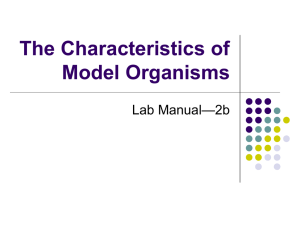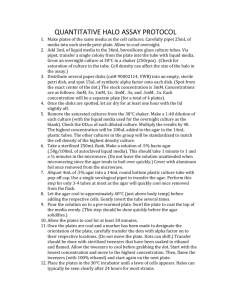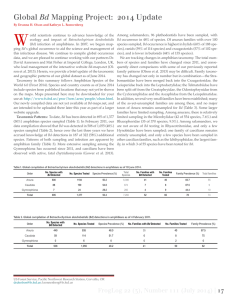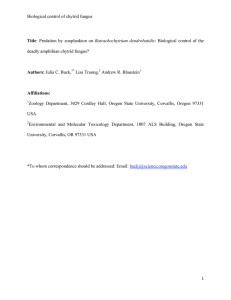Isolating Bd from Frog Skin
advertisement
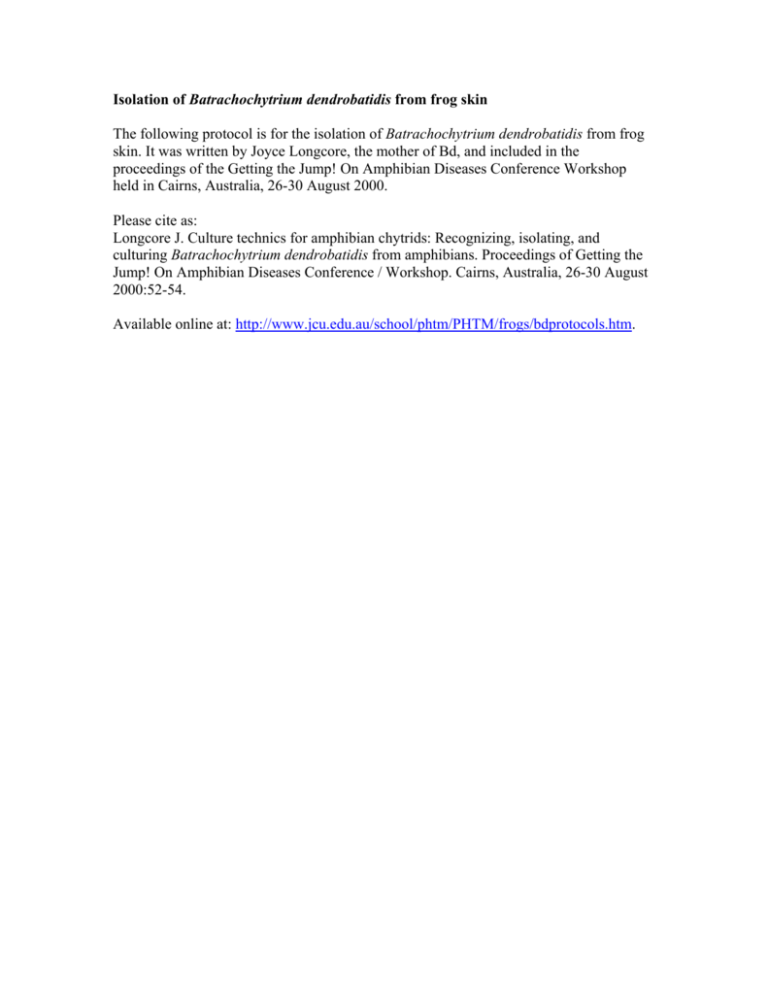
Isolation of Batrachochytrium dendrobatidis from frog skin The following protocol is for the isolation of Batrachochytrium dendrobatidis from frog skin. It was written by Joyce Longcore, the mother of Bd, and included in the proceedings of the Getting the Jump! On Amphibian Diseases Conference Workshop held in Cairns, Australia, 26-30 August 2000. Please cite as: Longcore J. Culture technics for amphibian chytrids: Recognizing, isolating, and culturing Batrachochytrium dendrobatidis from amphibians. Proceedings of Getting the Jump! On Amphibian Diseases Conference / Workshop. Cairns, Australia, 26-30 August 2000:52-54. Available online at: http://www.jcu.edu.au/school/phtm/PHTM/frogs/bdprotocols.htm. 9. TECHNICAL WORKSHOP DETAILS Saturday 26 August Histological diagnosis of chytridiomycosis Lee Berger, Diana Mendez, Rick Speare Please refer to papers in Appendix. Sunday, 27 August Culture Technics for Amphibian chytrids Recognizing, isolating, and culturing Batrachochytrium dendrobatidis from amphibians Joyce E. Longcore, Department of Biological Sciences, University of Maine, Orono, Maine 04469-5722 Collection: Collect dead (including roadkills) and moribund amphibians; cool as soon as possible; keep cool and damp but not waterlogged until examination and possible isolation attempts. Batracho-chytrium also can be isolated from the mouthparts of tadpoles. Collect tadpoles with abnormally keratinized mouthparts and examine microscopically for the infection. Sanitation: Incinerate or autoclave all discarded cultures and remains of amphibians. Sterilize (autoclave) water in which amphibians were carried. Recognition of chytridiomycosis: 1. Keep amphibian tissue damp but without free water. 2. Observe with dissecting microscope at 20 or 40 X. Use a sharp, sterile needle to remove loose skin from between digits of foot and elsewhere on the ventral surface of the animal. If skin is not loose, use needle-nosed forceps and tear pieces from the leading edge of the skin between the hind digits. 3. Place the skin on a microscope slide in a drop of sterile water and cover with a coverslip. 4. Observe with a compound microscope at 100 and 400 X. Look for walled, round bodies (10-30 µm diam) inside of epidermal cells. Some of the bodies (sporangia) may have cleaved zoospores within them, which will look like 5-20 spherical bodies within the sproangia. Other sporangia may have discharged their spores and appear empty. When the discharge tube is visible, the sporangium looks like a flask. Place infected skin on cleaning plate: If suspect organisms are found, follow steps 1 & 2 above; place the piece of skin on a 9 cm culture plate containing mTGhL nutrient agar and antibiotics, which are added after autoclaving (see recipe at end of document). If Getting the Jump! on amphibian disease 26-30 August 2000 Page 52 pieces of skin are thick and do not tear into small pieces, use micro-scissors and cut into small pieces while viewing with 20 X magnification. Clean bits of skin: While observing through a dissecting microscope (20-40 X magnification and substage lighting) use a sharpened and sterilized needle to draw and push a small (1 X 1 mm or less) piece of infected skin through nutrient agar in a 9 cm culture plate. Every few mm, take the needle away from the piece of skin and wipe through the agar. The purpose of wiping the skin and needle through agar is to remove bacteria, yeast and fungal spores. Bearing this in mind, reverse the direction of the skin, wipe it back and forth; imagine what you are trying to do even though you can not see the bacteria. Place cleaned skin on clean mTGhL plates. When the skin is well wiped (at least back and forth across the diameter of the plate one time), use the cleaned needle to remove it from the open cleaning plate and put it on a fresh plate of mTGhL agar. Barely open the fresh plate with one hand and wipe the skin piece into the agar with the needle held in the other hand. This is so that the pieces of skin will be on a plate that has not been exposed to fungal spores from the air. Repeat this process for as many pieces of skin as you have the patience; at a minimum, for each isolation attempt, put at least 6 pieces of wiped skin on each of two plates. Seal and label plates: Seal the nutrient agar plate with a 10 X 2-cm piece of Parafilm® or other laboratory film stretched around the circumference of the plate. Label the dish with a permanent marker, recording source of skin and date; circle on the bottom of the plate areas where each of the pieces of skin are located. Incubate at 23o C: Incubate sealed plates on the laboratory bench or, if laboratory temperatures are above 25o C, in an incubator at 20 to 23o C. Watch, Wait and Weed: During the next week to three weeks, check development by inverting the culture plate on the stage of a compound microscope and observing the small pieces of skin with the low power objective. Also inspect plates for contaminants. If fungal contaminants (weeds) are found, flame-sterilize a scalpel and remove. Motile Batrachochytrium zoospores (4-5 µm diam) may be evident around the cleaned, infected skin within 1-2 days, but sometimes not for several weeks. If chytrid colonies develop on the skin, they can be recognized as spherical bodies, some of which bear one or more nipple-like, discharge papillae. If hyphae are evident instead of round sporangia, use a sterile knife to aseptically remove the hyphal colony from the isolation plate. If Batrachochytrium colonies are produced on many pieces of skin, one piece can be removed to examine the fungus with the compound microscope. Open a plate using techniques to minimize the chances of entry of airborne fungal spores, and use a sterilized scalpel to remove a piece of the colony to a drop of water on a microscope slide. Observe with the compound microscope and compare morphology with published photographs of Batrachochytrium. Transfer: After the chytrid forms a colony on the isolation plate, aseptically transfer a piece of the colony to a plate of TGhL agar. This fungus grows best in groups, so do not separate sporangia from each other during transfer. Incubate for 1 or 2 weeks; if no bacteria develop and the fungus is growing well, spread the colony on the plate and transfer a part of the colony to nutrient broth in a screw-capped 250-ml flask. Make fresh plates of each isolate, seal with Parafilm®. Getting the Jump! on amphibian disease 26-30 August 2000 Page 53 Make stocks: For stocks, keep 2 sets of cultures in broth (H broth; recipe below) at 5o C. Stock cultures of other chytrids are kept on agar slants in screw-capped test tubes; however, I have had poor success with survival of Batrachochytrium on agar in tubes. If stocks are kept on nutrient agar, use sealed Petri plates. Refrigerated broth cultures have remained viable for more than 3 months. Recipes: mTGhL (add 200 mg/L penicillin-G and 200-500 mg/L streptomycin sulfate after autoclaving) 8 g tryptone 2 g gelatin hydrolysate 4 g lactose 10 g agar 1000 mL distilled water TGhL 16 g tryptone 4 g gelatin hydrolysate 2 g lactose 10 g of agar 1000 mL distilled water H broth 10 g tryptone 3.2 g glucose 1000 mL distilled water Getting the Jump! on amphibian disease 26-30 August 2000 Page 54

